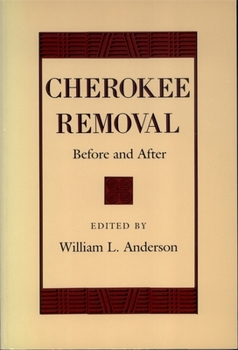Cherokee Removal: Before and After
Select Format
Select Condition 
Book Overview
In 1838 Cherokees in Georgia, Tennessee and North Carolina were forced at gunpoint to abandon their homes, farms, schools and churches and travel to a reservation in Oklahoma Territory. Their... This description may be from another edition of this product.
Format:Paperback
Language:English
ISBN:082031482X
ISBN13:9780820314822
Release Date:July 1992
Publisher:University of Georgia Press
Length:176 Pages
Weight:0.72 lbs.
Dimensions:0.6" x 6.0" x 9.0"
Customer Reviews
1 rating
A Great Collection of Essays
Published by Thriftbooks.com User , 17 years ago
"Cherokee Removal: Before and After" is a collection of concise, well written essays that serve as a gateway to the study of Cherokee History. The introduction, by Editor William Anderson, provides an overview for the essays and gives a summary of federal and state attitudes toward the Cherokees. The most interesting argument that Anderson makes is one to cast Andrew Jackson in a more favorable light. Contrary to many historians assertion that Jackson actively sought to remove and destroy Indians, Anderson says Jackson was "legally powerless" to act in favor of the Cherokees when the state of Georgia refused to abide by the Supreme Court's decision for the Cherokees in "Worcester v. Georgia". Anderson argues that Jackson overlooked Georgia's non-compliance in order to keep Georgia from joining South Carolina in open rebellion over the nullification of federal tariffs. It is an interesting idea that Anderson proposes, and one not always considered in standard texts of U.S. History. In addition to editing this book, Anderson contributes a wonderful bibliographical essay, a rich road map of sources for study of the Cherokees during prehistoric time, the colonial period, and federal influence. The first essay, by Douglas C. Wilms, examines how outsiders such as fur traders, missionaries, and the federal government instituted change in how the Cherokees farmed, apportioned and populated their land. The essay contains useful charts and maps showing where and how the Cherokees lived prior to their removal in the late 1830s to what is now Oklahoma. Wilms draws from a census of the Cherokee Nation in 1835 and puts the information in an easily understandable format. A key point of the essay is that the Cherokees came much further in "civilizing" themselves at the time of removal than the federal government was willing to recognize. The second composition, by Ronald N. Satz, provides a closer look at President Andrew Jackson. While some historians have portrayed Jackson as a devil in regard to his Native American policies, others have said his aims were benevolent and paternalistic. Satz compares the rhetoric versus the reality of the Jackson administration. Satz's analysis points out the danger of one dimensional simplification in history and discusses a variety of factors that influenced the fate of the Indians during the Jackson era. Theda Perdue writes the third essay, in which she examines the state of Cherokee politics at the time of removal. It is a particularly enlightening paper, disputing the contention by many white Americans of the time that the vast majority of Cherokees were in favor of removal but were held back by the aristocratic elite in their tribe. Perdue shows that the aristocrats and the common Cherokees were united against removal. The federal government, however, chose to negotiate with a group of ambitious "middle class" Cherokees who had previously been frustrated in their efforts to become wealthy and join the Cherokee ruling





